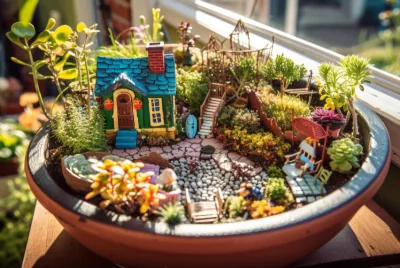Urban Gardening Success: Nurturing Plants in the Midst of Limited Spaces
Deprecated: The PSR-0 `Requests_...` class names in the Requests library are deprecated. Switch to the PSR-4 `WpOrg\Requests\...` class names at your earliest convenience. in /home/littlegr/public_html/wp-includes/class-requests.php on line 24
Welcome to the green revolution of urban gardening! In this post, we explore the burgeoning trend that is transforming cities into lush green havens. As an avid enthusiast and advocate of urban gardening, I am thrilled to share my personal journey and insights with you. Join me as we dive into the world of urban gardening, discover its many benefits, and explore how it has become a powerful movement. From small balconies to communal gardens, together we will unlock the secrets of cultivating nature’s beauty right in the heart of our bustling urban landscapes. Let’s embark on this green adventure and embrace the magic of urban gardening!
Benefits of Urban Gardening: Cultivating Green, Healthy, and Connected Communities
In the concrete jungles of urban landscapes, a green revolution is taking root. Urban gardening, once a niche activity, has blossomed into a powerful movement that brings numerous benefits to individuals, communities, and the environment. In this article, we explore the three key advantages of urban gardening: enhancing the environment and biodiversity, gaining access to fresh and healthy produce, and fostering community building and social engagement. Join me as we uncover the transformative power of urban gardening and discover why it has become a cherished endeavor for so many.
A. Enhancing the Environment and Biodiversity
Urban gardening offers a remarkable opportunity to transform barren spaces into thriving green oases. By cultivating plants, trees, and flowers, urban gardeners contribute to the overall greening of cities, creating pockets of beauty amidst the concrete. These green spaces act as natural air purifiers, filtering pollutants and reducing the urban heat island effect. Urban gardens also provide vital habitats for birds, bees, butterflies, and other pollinators, thus promoting biodiversity and ecological balance within urban ecosystems. Through urban gardening, we become stewards of the environment, nurturing nature right outside our doorstep.
B. Access to Fresh, Healthy Produce
One of the most enticing benefits of urban gardening is the ability to grow and harvest our own fresh and healthy produce. In an era when food miles and industrial agriculture dominate, urban gardens offer a direct connection to our food source. Imagine plucking a ripe tomato or snipping aromatic herbs from your balcony garden, knowing exactly where they came from and how they were grown. Urban gardening empowers us to take control of our food choices, ensuring the use of organic practices and minimizing the reliance on harmful pesticides. The joy of savoring homegrown fruits, vegetables, and herbs is unparalleled, providing us with nutritious and flavorful sustenance.
C. Community Building and Social Engagement
Beyond the greenery and the harvest, urban gardening has a remarkable capacity to bring people together, fostering a sense of community and social engagement. Community gardens and shared urban spaces become meeting points for individuals from diverse backgrounds, uniting them through a common love for nature and gardening. As gardeners tend to their plots, exchanging tips, knowledge, and stories, bonds are formed, and friendships are nurtured. Collaborative gardening projects encourage teamwork, cooperation, and a sense of collective responsibility. Whether in public parks or within residential complexes, urban gardens become vibrant hubs for social interaction, creating a sense of belonging and a shared purpose. Together, we cultivate not only plants but also meaningful connections.
Suitable Vegetables for Urban Gardening: Growing Fresh Delights Yourself
1. Leafy Greens: Lettuce, Spinach, Kale
Leafy greens are perfect choices for urban gardeners, as they grow well in small spaces and offer a continuous harvest. Lettuce, with its various varieties, thrives in containers and can be harvested as young leaves for fresh salads. Spinach, packed with nutrients, can be grown in compact pots or vertical planters. Kale, a nutritional powerhouse, adds texture and flavor to dishes and can be cultivated even in limited spaces. With these leafy greens, you’ll have a constant supply of vibrant, nutrient-rich greens right at your fingertips.
2. Herbs: Basil, Mint, Rosemary
Herbs are a delightful addition to any urban garden, providing aromatic flavors and fragrance. Basil, with its vibrant leaves, thrives in containers and adds a burst of freshness to salads, pasta, and sauces. Mint, known for its refreshing taste, is easy to grow and makes a refreshing addition to beverages and desserts. Rosemary, a hardy herb, offers an earthy aroma and can be grown in pots or even as a vertical accent plant. Having these herbs in your urban garden ensures a constant supply of culinary delights and aromatic pleasures.
3. Compact Vegetables: Tomatoes, Peppers, Radishes
Compact vegetables are well-suited for urban gardens, thanks to their ability to thrive in limited spaces. Tomatoes, available in various varieties, can be grown in containers, hanging baskets, or vertical planters, providing a delicious harvest for salads, sauces, and sandwiches. Peppers, whether sweet or spicy, flourish in pots and add a burst of color and flavor to your meals. Radishes, with their quick growth and compact size, are perfect for small gardens or even windowsill planters. These compact veggies offer a rewarding experience and allow you to enjoy the taste of homegrown produce.
Choosing the Right Location for Urban Gardening
A. Evaluating Available Space: Balconies, Rooftops, Windowsills
Urban gardening offers versatility when it comes to available space. Assess your surroundings and explore the potential of various locations. Balconies provide ample space for containers and vertical gardening systems. Rooftops offer opportunities for larger planters or even raised beds. Windowsills, with their proximity to sunlight, are ideal for compact herbs and smaller vegetables. Maximize your limited space by using hanging baskets on trellis, flower boxes over the balcony railings and stacking vertical pots. By making the most of your available space, you can create a thriving urban garden that fits seamlessly into your lifestyle.
B. Considerations for Sunlight and Shade
Sunlight plays a crucial role in the success of your urban garden. Before selecting your gardening spot, observe the sunlight patterns throughout the day. Most vegetables require at least 6 hours of direct sunlight, while some leafy greens and herbs can tolerate partial shade. Understanding the sunlight conditions in your chosen location will help you select the right vegetables that match the available light levels and ensure healthy growth.
C. Vertical Gardening Options
Vertical gardening offers an innovative solution for maximizing space in urban environments. By utilizing walls, trellises, or hanging structures, you can grow a variety of vegetables vertically, saving valuable ground space. Vining plants like tomatoes and cucumbers can be trained to climb trellises, while herbs can be grown in wall-mounted planters. Vertical gardening not only enhances the aesthetics of your urban garden but also allows you to grow more in a limited area.
Getting Your Hands Dirty: A Guide to Starting and Maintaining an Urban Garden
1. Preparing the Soil or Selecting Containers
Urban gardens can thrive in a variety of settings, from traditional garden beds to containers and raised beds. If you have access to a garden bed, ensure it’s free from debris and weeds. Loosen the soil using a garden fork or spade to improve drainage and aeration. Alternatively, if you’re working with limited space, containers offer a practical solution. Select containers that are large enough for root growth, have proper drainage holes, and use high-quality potting mix to provide the necessary nutrients.
2. Seed Selection and Planting Techniques
Selecting the right seeds is crucial for a successful urban garden. Consider the available space, sunlight conditions, and your personal preferences. Opt for compact varieties that are well-suited for containers or limited garden beds. Follow the planting instructions on the seed packets regarding depth and spacing. You can also start with seedlings if you prefer a head start. Plant the seeds or seedlings with care, ensuring they are properly watered after planting.
3. Proper Watering and Fertilization
Watering plays a vital role in the health and productivity of your urban garden. Provide sufficient water to keep the soil consistently moist but not waterlogged. Check the moisture level regularly by inserting your finger into the soil. Fertilization is equally important to ensure your plants receive the necessary nutrients. Use organic fertilizers or compost to enrich the soil and promote healthy growth. Follow the instructions on the fertilizer packaging and apply as needed throughout the growing season.
Maintaining and Caring for Urban Gardens
A. Regular Monitoring for Pests and Diseases
Keeping a watchful eye on your urban garden helps detect pests and diseases early, preventing them from wreaking havoc on your plants. Inspect your plants regularly, looking for signs of pests such as aphids, snails, or caterpillars. Use organic pest control methods like handpicking, insecticidal soaps, or companion planting to deter pests. Similarly, be vigilant for any signs of diseases such as fungal infections or wilting. Prompt action and proper plant care can minimize the impact of these issues.
B. Pruning and Harvesting Techniques
Pruning is an essential practice in urban gardening to promote healthy growth and maintain plant shape. Remove any dead or damaged foliage, and trim excessive growth to allow for proper air circulation. Additionally, harvesting at the right time ensures optimum flavor and continuous productivity. Harvest leafy greens when they reach the desired size, herbs when they are abundant, and vegetables when they are ripe. Regular harvesting encourages further growth and a continuous supply of fresh produce.
C. Seasonal Care and Crop Rotation
Urban gardens require seasonal care and crop rotation to optimize yield and minimize disease risks. Adjust your gardening practices based on the changing seasons, such as adjusting watering frequencies and providing shade during hot summers. Crop rotation involves changing the planting locations of different plant families each season. This practice helps prevent nutrient depletion and reduces the likelihood of pests and diseases. Rotate your crops annually, following a systematic plan to maximize garden health.
Overcoming Challenges in Urban Gardening
1. Limited Space and Maximizing Productivity
Limited space is a common hurdle for urban gardeners, but it shouldn’t dampen your green thumb aspirations. Embrace vertical gardening techniques to make the most of your available space. Install trellises, hanging baskets, or utilize wall-mounted planters to maximize vertical real estate. Additionally, employ container gardening with compact varieties and companion planting to optimize productivity. Take advantage of every nook and cranny, from balconies and windowsills to rooftop gardens and community plots.
2. Dealing with Urban Pollution and Soil Contamination
Urban environments often come with the challenge of pollution and soil contamination. Combat this obstacle by incorporating raised beds or containers with fresh, uncontaminated soil. Use organic mulch to create a protective barrier and improve soil quality. Regularly monitor air quality and take measures to minimize exposure to pollutants. Consider installing air purifying plants that can help filter toxins and enhance the overall environmental quality of your urban garden.
3. Engaging with the Local Community and Resources
Urban gardening is not just about plants; it’s also about building connections with the local community. Seek out local gardening groups, urban farming initiatives, or community gardens in your area. Engage in knowledge sharing, workshops, and collaborative projects. Connect with local businesses, schools, or nonprofits that may have resources or land available for gardening purposes. By collaborating and sharing experiences, you can tap into a wealth of knowledge, foster community spirit, and inspire others to embrace urban gardening.
Conclusion
As we reflect on the challenges overcome in urban gardening, it becomes evident that the rewards far outweigh the hurdles. The joy of witnessing plants thrive amidst the concrete jungle, the satisfaction of harvesting your own fresh produce, and the sense of community forged through shared experiences are priceless. With determination and creativity, you can transform small spaces into flourishing green havens. So, take the plunge, grab your gardening tools, and embark on the fulfilling journey of urban gardening.





